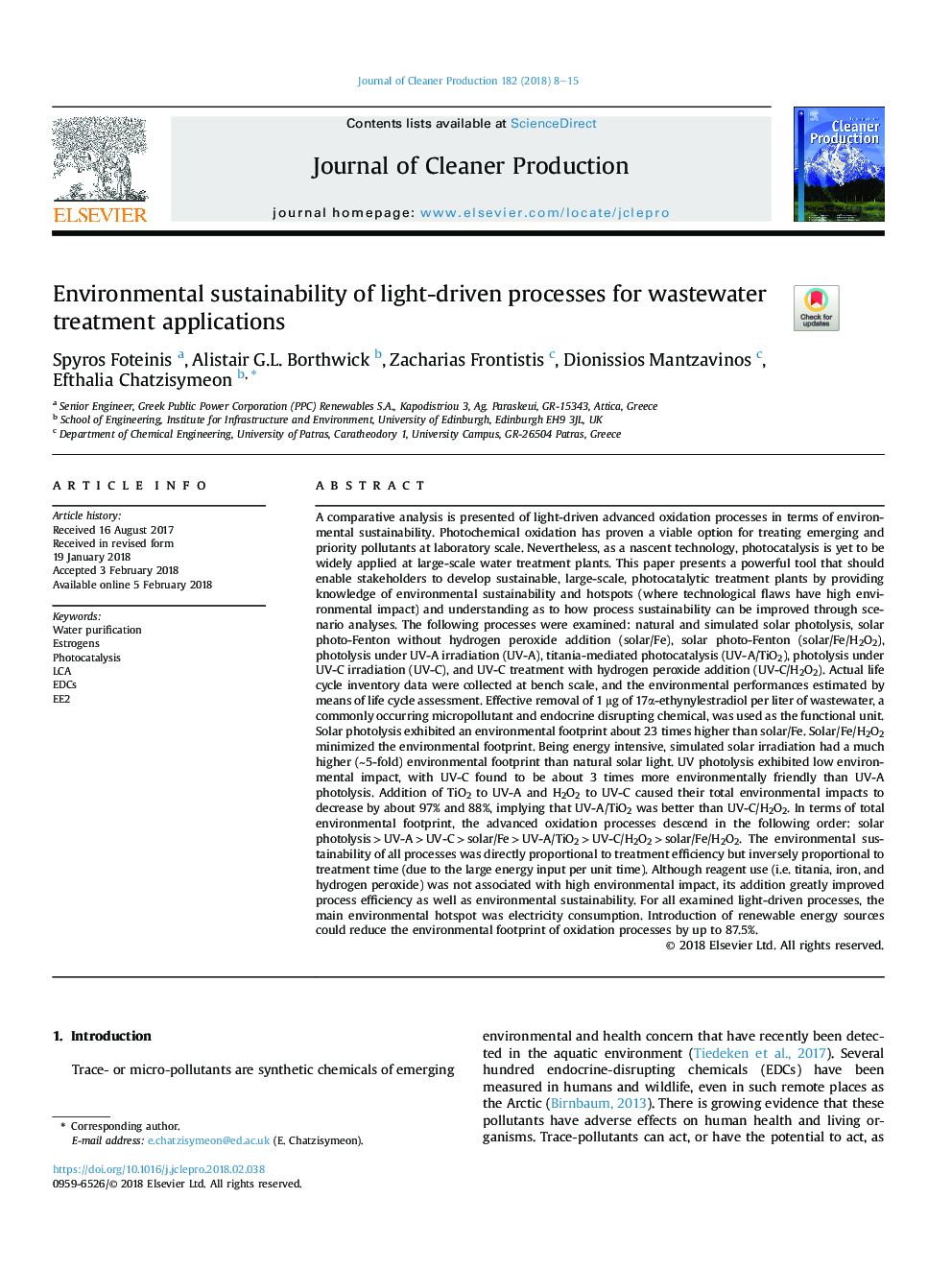| کد مقاله | کد نشریه | سال انتشار | مقاله انگلیسی | نسخه تمام متن |
|---|---|---|---|---|
| 8097244 | 1522071 | 2018 | 8 صفحه PDF | دانلود رایگان |
عنوان انگلیسی مقاله ISI
Environmental sustainability of light-driven processes for wastewater treatment applications
ترجمه فارسی عنوان
پایداری محیطی از فرایندهای نوری برای برنامه های کاربردی برای تصفیه فاضلاب
دانلود مقاله + سفارش ترجمه
دانلود مقاله ISI انگلیسی
رایگان برای ایرانیان
کلمات کلیدی
موضوعات مرتبط
مهندسی و علوم پایه
مهندسی انرژی
انرژی های تجدید پذیر، توسعه پایدار و محیط زیست
چکیده انگلیسی
A comparative analysis is presented of light-driven advanced oxidation processes in terms of environmental sustainability. Photochemical oxidation has proven a viable option for treating emerging and priority pollutants at laboratory scale. Nevertheless, as a nascent technology, photocatalysis is yet to be widely applied at large-scale water treatment plants. This paper presents a powerful tool that should enable stakeholders to develop sustainable, large-scale, photocatalytic treatment plants by providing knowledge of environmental sustainability and hotspots (where technological flaws have high environmental impact) and understanding as to how process sustainability can be improved through scenario analyses. The following processes were examined: natural and simulated solar photolysis, solar photo-Fenton without hydrogen peroxide addition (solar/Fe), solar photo-Fenton (solar/Fe/H2O2), photolysis under UV-A irradiation (UV-A), titania-mediated photocatalysis (UV-A/TiO2), photolysis under UV-C irradiation (UV-C), and UV-C treatment with hydrogen peroxide addition (UV-C/H2O2). Actual life cycle inventory data were collected at bench scale, and the environmental performances estimated by means of life cycle assessment. Effective removal of 1â¯Î¼g of 17α-ethynylestradiol per liter of wastewater, a commonly occurring micropollutant and endocrine disrupting chemical, was used as the functional unit. Solar photolysis exhibited an environmental footprint about 23 times higher than solar/Fe. Solar/Fe/H2O2 minimized the environmental footprint. Being energy intensive, simulated solar irradiation had a much higher (â¼5-fold) environmental footprint than natural solar light. UV photolysis exhibited low environmental impact, with UV-C found to be about 3 times more environmentally friendly than UV-A photolysis. Addition of TiO2 to UV-A and H2O2 to UV-C caused their total environmental impacts to decrease by about 97% and 88%, implying that UV-A/TiO2 was better than UV-C/H2O2. In terms of total environmental footprint, the advanced oxidation processes descend in the following order: solar photolysisâ¯>â¯UV-Aâ¯>â¯UV-Câ¯>â¯solar/Feâ¯>â¯UV-A/TiO2â¯>â¯UV-C/H2O2â¯>â¯solar/Fe/H2O2. The environmental sustainability of all processes was directly proportional to treatment efficiency but inversely proportional to treatment time (due to the large energy input per unit time). Although reagent use (i.e. titania, iron, and hydrogen peroxide) was not associated with high environmental impact, its addition greatly improved process efficiency as well as environmental sustainability. For all examined light-driven processes, the main environmental hotspot was electricity consumption. Introduction of renewable energy sources could reduce the environmental footprint of oxidation processes by up to 87.5%.
ناشر
Database: Elsevier - ScienceDirect (ساینس دایرکت)
Journal: Journal of Cleaner Production - Volume 182, 1 May 2018, Pages 8-15
Journal: Journal of Cleaner Production - Volume 182, 1 May 2018, Pages 8-15
نویسندگان
Spyros Foteinis, Alistair G.L. Borthwick, Zacharias Frontistis, Dionissios Mantzavinos, Efthalia Chatzisymeon,
